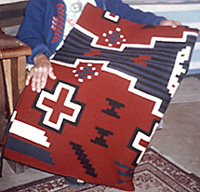Grace Henderson Nez

Courtesy of the artist
Bio
Grace Henderson Nez has lived her entire life in a hogan at the base of Ganado Mesa on the Navajo Reservation in Arizona. For more than seven decades, she has raised and sheared sheep, carded and dyed the wool, and wove intricate and distinctive Navajo rugs. In addition to creating textiles with complex and balanced designs, she reveals her technique in her ability to select the right wool quality, yarn weight, and weaving texture to produce strong and perfectly even rugs and blankets. Her works are in the late 19th century designs known as the "old style" as well as the distinct Ganado style, using brilliant red backgrounds with natural white, gray, brown, and black geometric patterns.
Scholar Ann Lane Hedlund estimates that there are more than 10,000 weavers on the Navajo Reservation. She suggests that Grace Henderson Nez is especially deserving of recognition because she combines artistic excellence with the traditional values and spiritual concentration that serve as a model for all weavers of the region. In 2002, Nez received the Lifetime Achievement Award from the Museum of Indian Arts and Crafts in Santa Fe.

|
Interview with Mary Eckstein
[Editor's note: Gloria Begay, Grace Henderson Nez's granddaughter, acted as translator for this interview]
NEA: Congratulations. How did you feel when you heard the news that you were being recognized with a National Heritage Fellowship?
MS. NEZ: I was almost in complete disbelief when I heard the news. I'm very happy my hard work has paid off.
NEA: How did you learn to weave? Why were you attracted to this art form and who were your influences?
MS. NEZ: My earliest memory of weaving is when I was 5 or 6 years of age. I was taught by my grandmother and aunt. I was attracted by the designs and the rewards for a completed rug.
NEA: What special skills or preparation does it take to excel at weaving? What are the most important elements for excellence and authenticity in the Navajo tradition?
MS. NEZ: To excel in weaving, a weaver must have a design plan in mind - size, color and which materials to use. Spiritually, a weaver is someone who is dedicated, a hard worker, independent, responsible, and has the will to teach and share with the younger generation. An authentic rug or artwork is displayed by spiritual participation.
NEA: What are the joys and challenges to making a living as a weaver?
MS. NEZ: The joys include the rewards, the ability to share the legacy, recognition, and monetary rewards. More importantly, it soothes me spiritually, emotionally, and psychologically.
The challenges include sustaining the desire to weave everyday, having to meet deadlines, having to limit materials at times and finding someone to help setup the wrap onto the loom. The physical challenges are the repeatitive motion and the aches and pains of sitting for long periods of time. It becomes tougher the older I get.
NEA: What are your favorite motifs or designs in your weaving?
MS. NEZ: Of course my favorite designs are the ones I'm known for - bold, geometric, Ganado reds. These have become my favorite because they are easy to work with and complete. These designs became my favorite not by choice but because of my physical condition and age.
NEA: What advice do you have for young Navajo weavers?
MS. NEZ: The younger generation is learning to weave and are incorporating new ideas that streamline with pop culture. Young Navajo weavers today have become competitive are not afraid to experiment and push the envelope.
My advice to young weavers is to continue teaching and sharing Navajo weaving. I let my children and grandchildren know that weaving is life. I feel I help by teaching and sharing my knowledge and skills with my grandchildren. The challenge is to get them interested in the artwork even though that interest means a lot of hard work.
NEA: What has inspired you to continue weaving through the years?
MS. NEZ: My children, grandchildren, and my great grandchildren are my inspiration for weaving. And weaving is my occupation, livelihood, and my life.

